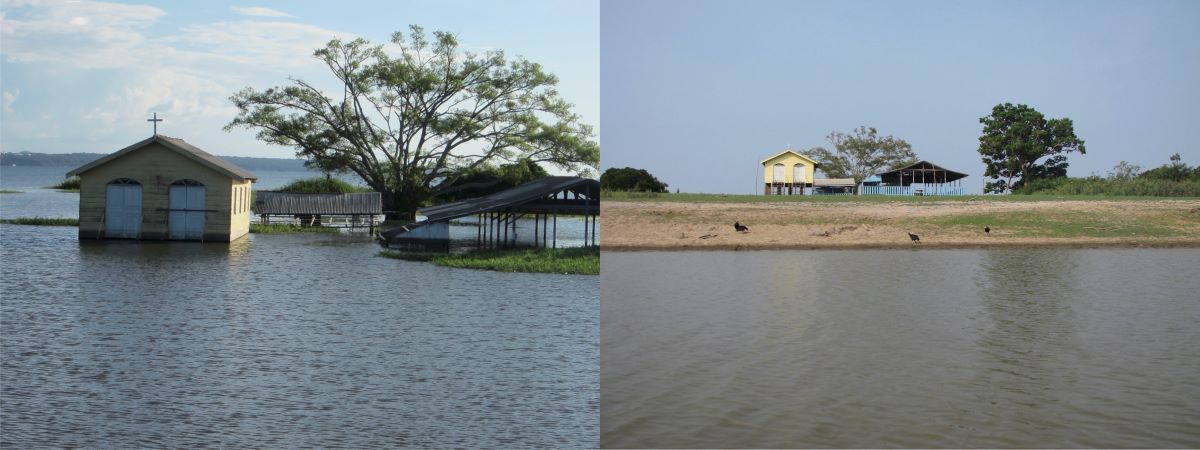

Amazon River water levels in the rainy season (left) and dry season near Santarém, Pará state, Brazil (photos: Júlia B. Gontijo)
Researchers at the University of São Paulo conducted an experiment to observe the effects on soil samples of extreme conditions in terms of temperature and rainfall in the laboratory. Their findings show that the balance of greenhouse gas emissions from microbial decomposition of organic matter may change.
Researchers at the University of São Paulo conducted an experiment to observe the effects on soil samples of extreme conditions in terms of temperature and rainfall in the laboratory. Their findings show that the balance of greenhouse gas emissions from microbial decomposition of organic matter may change.

Amazon River water levels in the rainy season (left) and dry season near Santarém, Pará state, Brazil (photos: Júlia B. Gontijo)
By Julia Moióli | Agência FAPESP – Extreme temperatures and humidity levels (excessive rain or drought) projected for the Amazon in the context of climate change may increase the volume of methane-producing microorganisms in flooded areas and reduce potential uptake of this greenhouse gas in upland forests by 70%, with global impacts, according to a study conducted by researchers at the University of São Paulo (USP) in Brazil. An article reporting their findings is published in the journal Environmental Microbiome. Effective conservation and management policies are all the more important in light of the results, the researchers said.
For at least six months every year, more than 800,000 square kilometers of floodplains in the Amazon Rainforest, equivalent to 20% of its total area, remain under several meters of water as a result of steady rainfall and rising levels of the region’s rivers. Methane production increases as microbial communities break down organic matter. Recent studies show that floodplains in the Amazon contribute up to 29% of global wetland methane emissions. On the other hand, the region’s upland forests act as methane sinks, capturing the gas from the atmosphere and playing an important role in the regulation of greenhouse gas emissions.
“Although it’s already been shown that factors such as air temperature and seasonal flooding can influence the composition of microbial communities and hence affect the flow of methane in these environments, what should we expect in the context of climate change and the projected alterations in rainfall and temperature patterns, with more intense extremes?” said Júlia Brandão Gontijo, first author of the article and currently a postdoctoral researcher at the University of California, Davis in the United States.
The study was supported by FAPESP via three projects (14/50320-4, 18/14974-0 and 19/25924-7), and was part of Gontijo’s PhD research at the Center for Nuclear Energy in Agriculture (CENA-USP), with Professor Tsai Siu Mui as thesis advisor. “We know atmospheric methane levels have risen about 18% in the last four decades,” Tsai said.
Partnering with colleagues affiliated with the Netherlands Institute of Ecology at the Royal Netherlands Academy of Arts and Sciences (NIOO-KNAW), Stanford University, the University of Massachusetts and the University of Oregon in the United States, and the Federal University of Western Pará (UFOPA) in Brazil, Gontijo conducted a 30-day experiment in which soil samples from two floodplains and an upland forest in Santarém and Belterra, municipalities located in the west of Pará state, were submitted to extreme temperatures (27 °C and 30 °C) and humidity.

Measuring field conditions and collecting soil samples for the experiment (photo: Fabiana S. Paula)
Methane producers and consumers were identified and measured by genetic sequencing and real-time quantitative PCR. “In both floodplains, although we didn’t observe significant changes in methane emission patterns, the number of methane-producing microorganisms increased, which may point to a future problem,” Gontijo said.
In addition, methane consumption by the upland forest soil fell 70% in warm and dry conditions, while methane production increased significantly during periods of heavy rain, precisely because the soil has not regularly had to deal with extreme humidity. For Gontijo, this is alarming.
“It means that the floodplain microbiome can adapt to climate change but the upland forest microbiome is sensitive to its effects, which could cause an alteration in the balance of greenhouse gas emissions in the Amazon region in future. In view of the Amazon Rainforest biome’s importance in proportion to global levels, this could represent a very serious problem,” she said.

Microcosm experiment designed to simulate the climate change conditions tested in the study (photo: Wanderlei Bieluczyk)
Methanotrophs
Microbiota and methane cycling in the Amazon will clearly be affected by climate change. In addition to their projections of an increase in methane emissions, the researchers also identified large numbers of methanotrophic microorganisms that use methane as an energy source and have the potential to offset this increase. They now plan to conduct field experiments and laboratory trials involving microorganisms in order to understand the dynamics of methane cycling more profoundly.
“In any event, the information we have garnered so far is extremely important and can be used in the formulation of public policies,” Gontijo said.
The article “Methane-cycling microbial communities from Amazon floodplains and upland forests respond differently to simulated climate change scenarios” is at: environmentalmicrobiome.biomedcentral.com/articles/10.1186/s40793-024-00596-z.
Republish
The Agency FAPESP licenses news via Creative Commons (CC-BY-NC-ND) so that they can be republished free of charge and in a simple way by other digital or printed vehicles. Agência FAPESP must be credited as the source of the content being republished and the name of the reporter (if any) must be attributed. Using the HMTL button below allows compliance with these rules, detailed in Digital Republishing Policy FAPESP.





